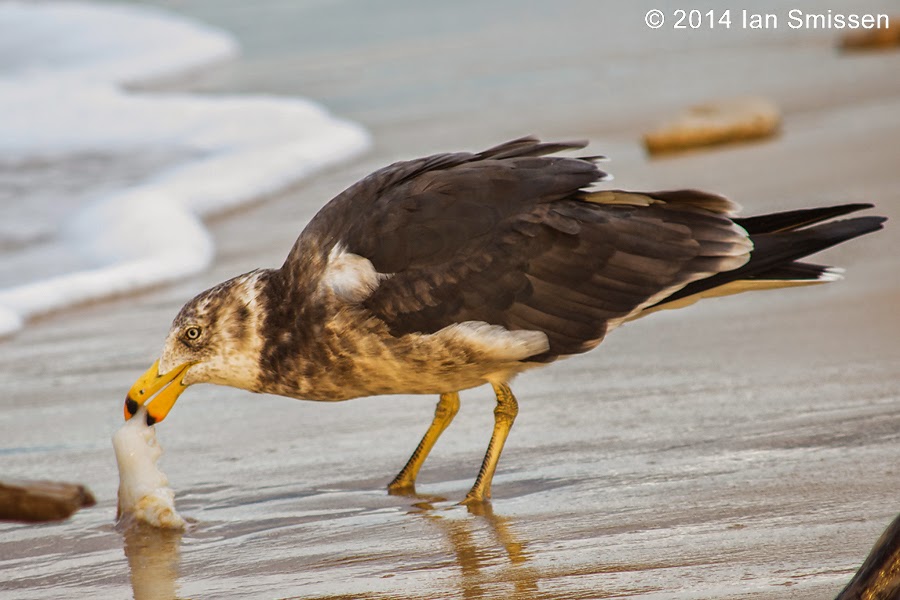I spent another great day out with the Birdlife Australia Melbourne Photography group today, covering various sights on the Mornington Peninsula. First stop at Cape Schanck meant an early rise to catch the ferry from Queenscliff to Sorrento. The sun was rising as the ferry departed Queenscliff, providing some great views of Port Phillip Bay.
 |
| Sunrise over Swan Island and Port Phillip Bay |
This trip frequently gives good views of several species of seabirds (including Australasian Gannets that breed on nearby Popes Eye and several channel markers in the south of Port Phillip Bay) as well as fur seals and dolphins but I was a little early for much wildlife activity this morning. However, I did manage to catch a few sleeping
Little Pied Cormorants as the ferry passed by a channel light.
 |
| Little Pied Cormorant, Port Phillip Bay |
I got to Cape Schanck before the scheduled meeting time so took the loop walk that gives great views of Bushranger Bay, Cape Schanck and the lighthouse.
 |
| Bushranger Bay from Cape Schanck |
 |
| Cape Schanck |
 |
| Cape Schanck Lighthouse |
The strong N-W wind made it a tough day for birding. We did manage to find more than 20 species of birds in an hour, including Shy and Black-browed Albatross (cruising past the Cape several hundred metres offshore), Pacific, Kelp and Silver Gull and a range of bush birds but none was willing to brave the wind to give us any worthwhile photographic moments. This
Shy Albatross was about as close as any got while we were there.
 |
| Shy Albatross, Cape Schanck |
Next stop was the ocean Beach at Flinders where, again, the windy conditions kept the birdlife scarce but made for some interesting seascape opportunities.
 |
| Ocean Beach, Flinders |
A small flock of the ubiquitous
Silver Gull made interesting photographic subjects floating on the waves just offshore. I wanted to try and get all the birds in focus so closed the aperture down to f/8 (effectively f/16 as I was using the 2x teleconverter). This made the shutter speed very slow (1/25th of a second - almost impossible to shoot moving birds at this speed) so I bumped up the ISO to 1600, which gave me a shutter speed of 1/100th--not ideal but the best I could do.
 |
| Silver Gull, Flinders |
This
Willie Wagtail entertained several of us for about 20 minutes, allowing very close approach of up to ten photographers while it hunted for small invertebrates amongst the seaweed along the edge of the dunes. The dull light and a fast-moving bird made photographing in the natural light challenging due to slow shutter speeds so I took the opportunity to practice some more flash photography. The best images resulted from using manual flash and dropping the power down to 1/8th. The lower power makes for a very fast flash which freezes the action and also makes it easier to balance the flash with the natural light reducing the shadows.
 |
| Willie Wagtail, Flinders |
After a picnic lunch, on the more sheltered jetty side of Flinders, we headed to Green's Bush (part of the Mornington Peninsula National Park see
Parknotes) and took the Circuit Track from Baldry's Crossing Picnic Area. This walk passes through a stringy bark forest with dense undergrowth providing great habitat for a wide range of bushbirds.
 |
| Green's Bush, Mornington Peninsula National Park |
Forests are always challenging habitats for bird photography as the canopy cuts much of the natural sunlight and many of the birds are high in the trees so they are a long way up and are nearly always silhouetted against a bright background sky. That said, with patience, you can usually locate a range of birds that will eventually become more photographic. My favourite strategy is to walk slowly along the track listening and looking for movement, until I find a suitable location to sit or stand and wait for the birds to come to me. This is harder to do in a large group but we did see more than 20 species in an hour walk. My photographic highlights were...
 |
Eastern Yellow Robin
Green's Bush, Morning Peninsula National Park |
 |
Fan-tailed Cuckoo
Green's Bush, Mornington Peninsula National Park |
After a final bird count for the day, we parted company and went our separate ways, in my case heading back to Sorrento for the return ferry trip.
...but wait, there's
more...






















































